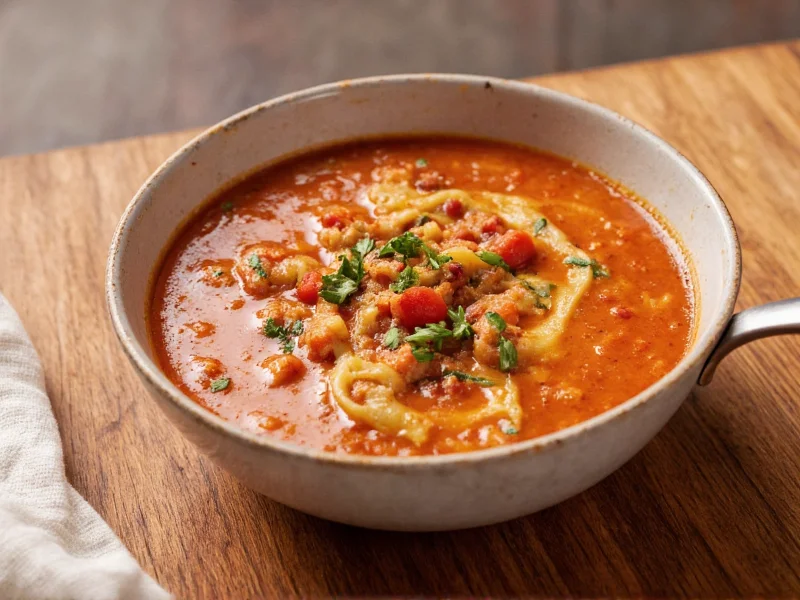When you search for a tuscan soup recipe, you're likely seeking more than just ingredients—you want an authentic experience that captures the essence of Tuscany's culinary tradition. Ribollita, which literally means "reboiled," was historically made by reheating leftover minestrone with stale bread, creating a nourishing meal from simple pantry staples. Today, this rustic soup remains a beloved representation of cucina povera ("poor kitchen")—Italian cooking that transforms humble ingredients into something extraordinary.
The History Behind Authentic Tuscan Soup
Ribollita dates back centuries to Tuscany's farming communities, where nothing went to waste. Peasants would combine leftover vegetables, beans, and bread with water and olive oil, then reheat the mixture daily, adding new ingredients as available. The repeated reheating process allowed flavors to deepen while making the most of limited resources. Unlike many modern adaptations, traditional ribollita contains no meat, reflecting its origins as a dish for lean times and religious fasting periods.
Essential Ingredients for an Authentic Experience
What makes a traditional tuscan vegetable soup stand apart from other minestrones? The specific combination of ingredients matters more than you might think:
| Core Ingredient | Traditional Purpose | Substitution Notes |
|---|---|---|
| Cannellini beans | Provides creaminess and protein | Great northern beans work, but avoid red beans |
| Black kale (cavolo nero) | Distinctive earthy flavor | Lacinato kale is acceptable; regular kale less traditional |
| Stale rustic bread | Thickens soup and adds heartiness | Must be unsalted Tuscan bread or similar unsalted variety |
| Extra virgin olive oil | Essential flavor base | Never substitute with other oils |
Step-by-Step Preparation Guide
Creating an easy tuscan white bean soup that stays true to tradition requires attention to technique more than complexity:
- Soak beans overnight (or use quick-soak method) - dried beans yield better texture than canned
- Sauté vegetables slowly in olive oil until softened but not browned (the soffritto base)
- Add tomatoes and herbs, simmering until flavors meld (about 20 minutes)
- Incorporate cooked beans and broth, bringing to gentle simmer
- Add chopped kale and simmer until tender (15-20 minutes)
- Cool slightly, then add bread - traditional method involves layering bread between soup portions
- Refrigerate overnight - crucial step that allows flavors to develop fully
- Reheat gently the next day, adding more broth if needed
Pro Tips for Perfect Tuscan Soup Every Time
Mastering this hearty tuscan bean soup recipe involves understanding some key techniques:
- The bread matters: Authentic Tuscan bread is unsalted, which affects both texture and flavor absorption. If unavailable, use a rustic unsalted loaf or reduce added salt accordingly.
- Don't rush the soffritto: Cooking the onion, carrot, and celery base slowly in olive oil creates the flavor foundation. Rushing this step produces a harsher flavor.
- Season at the end: Beans absorb salt differently when cooked, so final seasoning after reheating yields better results.
- Texture is key: Traditional ribollita should be thick enough to hold its shape when served—a spoon should stand upright in it.
Adapting to Modern Kitchens and Diets
While purists might frown, these thoughtful adaptations maintain the spirit of the dish while accommodating different needs:
- Vegetarian/vegan: Traditional ribollita is already plant-based—just ensure your bread contains no dairy or eggs
- Gluten-free: Substitute bread with gluten-free rustic loaf or omit entirely, thickening with additional pureed beans
- Time-saving version: Use quality canned beans (drained and rinsed) and skip the overnight refrigeration, though flavor will be less developed
- Pressure cooker method: Cook beans and vegetables together for 15 minutes at high pressure, then finish with kale and bread
Serving Tradition with Your Tuscan Soup
In Tuscany, ribollita is typically served as a main course with these traditional accompaniments:
- A generous drizzle of high-quality extra virgin olive oil added just before serving
- Freshly cracked black pepper
- A wedge of pecorino cheese on the side (not stirred in, as traditionally it's a peasant dish without cheese)
- Simple green salad with lemon vinaigrette to cut the richness
- Chianti wine, which complements the earthy flavors perfectly
Remember that authentic tuscan soup with kale and beans improves with time—many cooks believe day-old ribollita tastes even better than freshly made. The bread continues to absorb flavors while the vegetables meld together, creating a more cohesive dish.
Storage and Reheating Instructions
Proper storage maintains the integrity of your traditional tuscan bean soup:
- Cool completely before refrigerating to prevent condensation
- Store in airtight container for up to 5 days
- Freeze portions for up to 3 months (without bread, which becomes mushy)
- Reheat gently over medium-low heat, adding small amounts of water or broth as needed
- Never boil vigorously after adding bread, as this breaks down the texture











 浙公网安备
33010002000092号
浙公网安备
33010002000092号 浙B2-20120091-4
浙B2-20120091-4